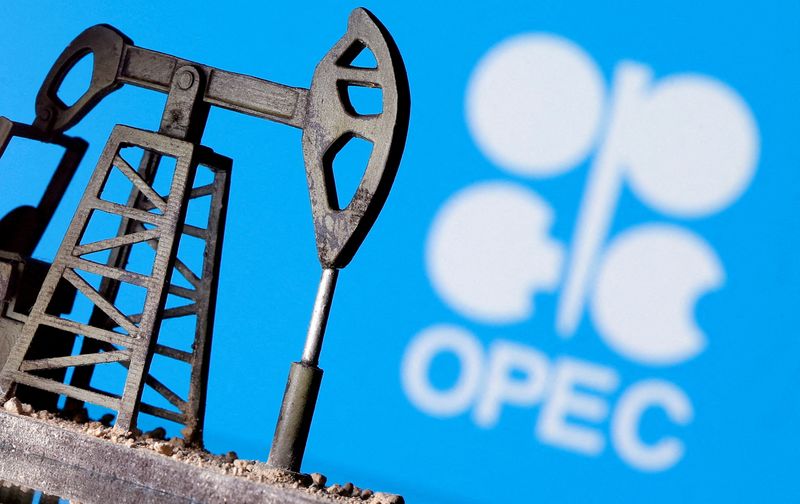By Georgina McCartney and Liz Hampton
HOUSTON/DENVER (Reuters) -The oil industry and markets have had a muted reaction to growing conflict in the Middle East, a sign of just how well stocked oil supplies are as U.S. output grows and OPEC+ prepares to lift production.
The global oil benchmark Brent jumped 5% on Tuesday after Iran, a key producer and member of the Organization of the Petroleum Exporting Countries, attacked Israel in retaliation for its campaign against Hezbollah in Lebanon.
The price of Brent settled on Tuesday only 2.6% higher at $73.56, however, broadly in line with last week's levels. Oil futures settled up just 34 cents on Wednesday after the U.S. reported a large build in oil stocks. [O/R]
The U.S. is pumping some 13.4 million barrels per day of oil and its output is anticipated to climb to a record 13.49 million bpd by the end of the year, according to U.S. government data. Meanwhile, OPEC and its allies, a group known as OPEC+, which has been focused on cutting production since 2022, is set to start raising output later this year.
In the past, such escalating conflict in oil-producing regions of the world would have been expected to have a bigger and lasting impact on prices. But there is enough supply and concerns about soft demand to buffer the market from those events.
"In this new world of U.S. shale being the dominant global oil producer, it seems that the 'fear premium' no longer exists to the same extent," said Rhett Bennett, the CEO at Black Mountain Energy, which has operations in the Permian basin and Western Australia.
"This diversity of supply from domestic sources, combined with healthy spare capacity within OPEC, is translating into the market feeling insulated from a dramatic supply shock – regardless of perpetual Middle East flare-ups," Bennett added.
Global crude supplies have yet to be disrupted by the war in the Middle East and Iran-aligned Houthi rebel attacks on vessels in the Red Sea.
As a result of its years of production cuts, OPEC+ has a sizeable spare capacity and this has limited the upside for prices from escalating conflict in the Middle East, analysts have said, as other producers could in theory compensate for supply disruptions.
The International Energy Agency estimates OPEC+ spare production capacity at 5.7 million bpd, nearly 6% of oil consumption, with Saudi Arabia accounting for 54% of the buffer. This is more than Iran's production of 3.4 million bpd.
US PRODUCERS HOLD STEADY
The price of Brent fell 17% in the third quarter and 9% in September, its largest monthly decline since November 2022, in part due to downward revisions to OPEC's global demand growth outlook. West Texas Intermediate was down 16% for the quarter and 7% for the month to $68.17 a barrel.
"The U.S. has so much production, it is a strategic cushion," said Dan Pickering, chief investment officer at Pickering Energy Partners. "I think the supply and demand equation is unchanged, even though the risks of the supply and demand equation are changing."
While oil may draw some immediate support from the developing conflict in the Middle East, it is unlikely to spur U.S. operators to quickly ramp up production, said Pickering and other shale oil executives.
Many are exercising caution as OPEC+ plans to add an additional 180,000 bpd to the global market in December, and some analysts have said a lack of compliance by members that are over-producing could prompt Saudi Arabia and others to raise output even faster from December.
"It's too soon to weigh these events against actions OPEC may or may not take to affect supply," said Michael Oestmann, the CEO of Tall City Exploration, a producer in Midland, Texas.
"It is unlikely that this will incentivize drilling or cause any change in business plans," he added.
OPEC+ is currently cutting output by a total of 5.86 million bpd, or about 5.7% of global demand.
Analysts at consultancy Wood Mackenzie are forecasting higher Brent prices for October at $81 per barrel. They noted that this could be revised up or down depending on whether escalation in the Middle East is avoided.

Brent futures rose 34 cents, or 0.46%, to settle at $73.90 per barrel on Wednesday, while U.S. West Texas Intermediate crude settled up 27 cents, or 0.39%, to $70.10 per barrel.
"We see it as a temporary uptick, but if the war goes longer and more countries are involved, then prices could stay elevated," said Mark Marmo, the CEO of Deep Well Services, Zelienople, Pennsylvania-based oilfield firm.